| Latest | Greatest | Lobby | Journals | Search | Options | Help | Login |
|
|
|
This topic is archived. |
| Home » Discuss » Topic Forums » Sports |
|
| Jack Rabbit
|
Sun Feb-01-09 02:32 PM Original message |
| The Jack Rabbit Chess Report (February 1): Youth Triumph in Wijk aan Zee |
|
Hail to Youth: Three Teenagers Win in Wijk
 Ukrainian grandmaster Sergei Karjakin, 19, Italian national champion Fabiano Caruana, 16, and Filipino GM Wesley So, 15, are the winners of their respective divisions in the annual Corus Chess Tournament in the Dutch seaside town of Wijk aan Zee completed just a few minutes ago. Karjakin started the day's 13th and final round as one of six grandmasters tied for the top position in Group A with 7 points each. He won his game against one of the other six, Cuban grandmaster Lenier Domínguez. Norway's Magnus Carlsen, not exactly long in the tooth at 18, lost his bid to tie Karjakin when he fell to Chinese GM Wang Yue in a heartbreaking 67-move Rook-and-pawn ending. The other three -- Teimour Radjabov (Azerbaijan), Sergei Movsesian (Slovakia) and Levon Aronian (Armenia) -- all drew their respective game to finish in a second-place tie. In Group B, Caruana leaped over British GM Nigel Short when he defeated the former world championship contender in 67 moves today. Caruana started the day with 7½ points, a half-point behind Short. Caruana was born in Miami, Florida, and grew up in New York, where at the age of seven he became a pupil of the American chess trainer Bruce Pandolfini. As the son of an Italian-American father and an Italian mother, he holds dual citizenship with the United States and Italy and represents Italy in international competitions. Short lost a world championship match to then-champion Garry Kasparov in 1993, when Caruana was a year old. Young Wesley So clinched at least a tie for first place in Group C yesterday when he defeated his nearest rival, Sweden's Tiger Hillarp Persson, to take a one-point lead over the field with 9 points. Needing only to avoid loss today to win the event outright, So played cautiously and drew with 17-year-old British GM David Howell in just 19 moves. Hillarp Persson finished in a second place tie with 14-year-old Anish Giri, a young man with a Russian mother and a Nepalese father who all reside in Holland. Young Anish, who carried the title federation master until now, earned his final require grandmaster norm in Wijk aan Zee and will be named a grandmaster later this year if he can get his Elo score over 2500. Gibraltar Chess Festival Begins: Beliavsky Leads  Gibraltar monkey from The Independent (UK) Alexander Beliavsky of Slovenia leads the 7th annual Gibtelecom Masters Tournament with 5½ points after six rounds at the Gibraltar Chess Festival after six rounds on the British-controlled situated in the straight between Spain and Morocco. In contrast to the youth movement in Wijk aan Zee, Beliavsky is 55. Beliavsky entered today's round tied with Vasilios Kotronias of Greece at 4½ points each. Beliavsky, playing White, won a Rook-and-pawn ending in 53 moves. The ten-round event goes through Thursday. Calendar Gibraltar Chess Festival 27 January-5 February. Moscow Open 30 January-9 February. Aeroflot Open, Moscow 16-27 February. Topalov-Kamsky World Championship Semifinal Match, Sofia 16-28 February. Eight Rounds. Winner will challenge Anand for the world championship. Linares Grandmaaster Tournament 18 February-8 March. Cappelle la Grande Open 28 February-7 March. Reykjavik Open 4-13 March. European Individual Championships, Budva (Montenegro) 5-19 March. Foxwoods Open, Mashantucket, Connecticut April 8-12. MTel Masters, Sofia May 9-19. Aerosvit International Tournament, Foros (Ukraine) June 9-20. Games will be posted later. |
| Printer Friendly | Permalink | | Top |
| nickgutierrez
|
Sun Feb-01-09 06:17 PM Response to Original message |
| 1. Looking through the PGN database, I found one interesting tidbit. |
|
Of the 11 games in the Najdorf, 4 of them were won by White, and the other 7 were draws.
This only jumped out to me because I've been studying that opening. It's incredibly complicated, and this makes me wonder whether White is gaining an advantage at least at the very highest levels, against it. |
| Printer Friendly | Permalink | | Top |
| Jack Rabbit
|
Sun Feb-01-09 06:49 PM Response to Reply #1 |
| 2. The Najdorf is very "sharp" |
|
For the benefit of the uninitiated who may be reading this, that means one had better possess a lot of theoretical knowledge before playing it.
Eleven games isn't a big sample, so I just tried this. On ChessGames.com, I took all available games with the Najdorf played by Walter Browne as Black, to use a known expert in the defense. There were 117 games. Browne won 45, lost 35 and drew 37. Most of these games would be against players of grandmaster strength. |
| Printer Friendly | Permalink | | Top |
| Jack Rabbit
|
Sun Feb-01-09 06:51 PM Response to Original message |
| 3. This week's games |
|
The "big three" will be posted first, with six others to follow.
Your humble hare acknowledges the assistance of Fritz 6.0 on analysis. Diagrams on the Jack Rabbit Chess Report are made with Chess Mérida, a true type font that can be downlaoded free here. !""""""""# $tMvWlVmT% $OoOoOoOo% $ + + + +% $+ + + + % $ + + + +% $+ + + + % $pPpPpPpP% $RnBqKbNr% /(((((((() WHITE White to move (This position is a theoretical draw) |
| Printer Friendly | Permalink | | Top |
| Jack Rabbit
|
Sun Feb-01-09 06:52 PM Response to Reply #3 |
| 4. Karjakin - Movsesian, Corus A, Round 9, Wijk aan Zee |
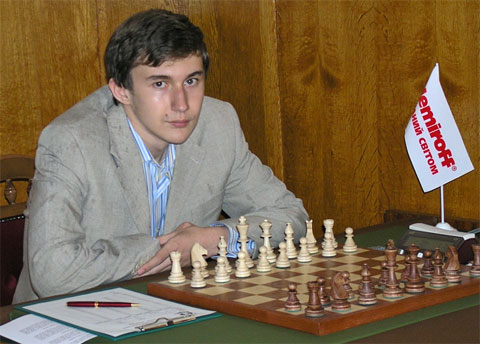 Sergey Karjakin Sergey Karjakin - Sergei Movsesian Corus Chess Tournament (Group A), Round 9 Wijk aan Zee, 27 January 2009 Open Sicilian Game: Scheveningen Defense 1.e4 c5 2.Nf3 d6 3.d4 cxd4 4.Nxd4 Nf6 5.Nc3 e6 6.Be3 Nc6 7.f3
7...Be7 8.Qd2 0-0 9.g4 d5
10.g5 Nxd4
11.Qxd4 Nh5 12.0-0-0
12...Bxg5 13.Kb1 Kh8
14.Bxg5 Qxg5 15.Rg1 Qf4!?
16.Qc5
16...Bd7 17.exd5 Nf6
18.Bh3
18...exd5!?
19.Bxd7
19...Nxd7 20.Qxd5 Nf6 21.Qxb7 Qxh2 22.Ne4
22...Nxe4
23.Qxe4 Rad8 24.a4
24...Qc7 25.Rxd8
25...Rxd8 26.Rg5 g6 27.Rb5
!""""""""# $ + T + L% $P W +o+o% $ + + +o+% $+r+ + + % $o+ +q+ +% $+ + +p+ % $ Pp+ + +% $+k+ + + % /(((((((() WHITE: Sergey Karjakin Position after 27.Rg5b5 27...Rd1+!
28.Ka2 Rd7 29.c4!
!""""""""# $ + + + L% $O Wt+o+o% $ + + +o+% $+r+ + + % $p+p+q+ +% $+ + +p+ % $kP + + +% $+ + + + % /(((((((() WHITE: Sergey Karjakin Position after 29.c2c4 29...Kg7
30.c5 a6 31.c6!?
31...axb5!
32.cxd7 Qxd7 33.Qe5+
33...Kf8!
!""""""""# $ + + L +% $+ +w+o+O% $ + + +o+% $+o+ Q + % $p+ + + +% $+ + +p+ % $kP + + +% $+ + + + % /(((((((() WHITE: Sergey Karjakin Position after 33...Kg7f8 34.axb5!
34...h5
35.Kb3
35...Kg8
36.b6!
36...h4
37.Qc7
37...Qd1+ 38.Kb4 Qe1+
39.Kb5 Qe2+ 40.Ka5 Qd2+ 41.b4
41...Qa2+ 42.Kb5 Qe2+ 43.Qc4 Qe8+ 44.Qc6
44...Qe2+
45.Kc5 Qf2+ 46.Kd6 Qg3+?
!""""""""# $ + + +l+% $+ + +o+ % $ PqK +o+% $+ + + + % $ P + + O% $+ + +pW % $ + + + +% $+ + + + % /(((((((() WHITE: Sergey Karjakin Position after 46...Qf2g3+ 47.Kd7!
47...h3
48.b7 h2 49.Qc8+ Kg7
50.b8Q Qxb8
51.Qxb8 h1Q 52.Qe5+ Kg8 53.Qd5 Qh3+ 54.Kc7 Qh2+ 55.Kb7 !""""""""# $ + + +l+% $+k+ +o+ % $ + + +o+% $+ +q+ + % $ P + + +% $+ + +p+ % $ + + + W% $+ + + + % /(((((((() WHITE: Sergey Karjakin Position after 55.Kc7b7 55...Qh5!?
56.Kc6!
56...Qh3 57.Kb7 Qh5 58.Qc6
58...Kg7 59.b5 Qe5 60.b6 g5 61.Kc8 Qf5+ 62.Kd8!
62...Qa5 63.Qd6 Qa8+ 64.Kc7 Qxf3 65.b7 Qc3+ 66.Kd7 Qh3+ 67.Kd8 Qh8+ 68.Kc7 1-0
|
| Printer Friendly | Permalink | | Top |
| Jack Rabbit
|
Sun Feb-01-09 06:54 PM Response to Reply #3 |
| 5. Caruana - l'Ami, Corus B, Round 9, Wijk aan Zee |
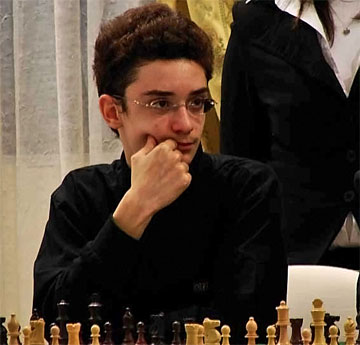 Fabiano Caruana Fabiano Caruana - Erwin l'Ami Corus Chess Tournament (Group B), Round 9 Wijk aan Zee, 27 January 2009 Slav Queen's Gambit: Tikhi Opening (Jussupow Defense) 1.Nf3 d5 2.d4 Nf6 3.c4 c6 4.e3 Bg4
5.h3 Bxf3
6.Qxf3 e6 7.Nc3 Nbd7 8.Bd2
8...Bd6
9.cxd5
9...exd5 10.Bd3 Nf8!?
11.g4
11...Ne6 12.h4 Qe7 13.Qe2
13...0-0-0 14.0-0-0 Kb8 15.Kb1
15...Nd7 !""""""""# $ L T + T% $Oo+mWoOo% $ +oVm+ +% $+ +o+ + % $ + P +pP% $+ NbP + % $pP BqP +% $+k+r+ +r% /(((((((() WHITE: Fabiano Caruana Position after 15...Nf6d7 16.f4!?
16...Ka8!?
17.Rc1
17...Nb6
18.Qf2 Rhe8 19.Rhe1 Qf8
20.g5 f5 21.gxf6 Qxf6 22.h5 g6
23.hxg6 hxg6 24.Rg1 Nf8
25.Rg5
25...Qf7 26.Rcg1 Re6 27.Bc1 Nc8
28.e4
28...Be7?!
29.exd5 Bxg5 30.dxe6 Nxe6 31.Be3 Bxf4?
32.Rxg6!
32...Rf8 !""""""""# $l+n+ T +% $Oo+ +w+ % $ +o+m+r+% $+ + + + % $ + P V +% $+ NbB + % $pP + Q +% $+k+ + + % /(((((((() WHITE: Fabiano Caruana Position after 32...Rd8f8 33.Rxe6!!
33...Qxe6 34.Bxf4 Qf6 35.Ne2 Ne7
36.Qg2 Nd5 37.Bd2 Qh8
38.a3 Rg8 39.Qf3
39...Rf8 40.Qg2
40...Rg8 41.Qe4 Re8 42.Qg6 Nc7
43.Bf4 Nd5 44.Be5 Qf8 45.Be4
45...Rd8 46.Bxd5 Rxd5 47.Nf4 Rd7 48.Ne6 Qc8 49.Qf6 Rh7
50.Nf8 Rh5 51.Qe7 Rh1+ 52.Ka2 a6 53.Ne6 Qg8
54.d5 cxd5 55.Nc7+ Ka7 56.Bd4+ 1-0
|
| Printer Friendly | Permalink | | Top |
| Jack Rabbit
|
Sun Feb-01-09 06:56 PM Response to Reply #3 |
| 6. Pressijers - So, Corus C, Round 10, Wijk aan Zee |
 Wesley So Roeland Pruijssers - Wesley So Corus Chess Tournament (Group C), Round 10 Wijk aan Zee, 28 January 2009 Open Sicilian Game: Taimanov Defense 1.e4 c5 2.Nf3 Nc6 3.d4 cxd4 4.Nxd4 Qc7 5.Nc3 e6 6.Be3 a6 7.Qd2 Nf6 8.0-0-0 Bb4 9.f3 Ne5 10.Nb3 b5 11.Qd4
11...Be7
12.Qb6
12...Qxb6 13.Bxb6 d6 14.a3!?
14...0-0 15.Na5 Bd7 16.f4 Nc6 17.Be2
17...Rfc8 18.Bf3 Rab8 19.Nxc6 Bxc6 20.Ba5
20...Nd7 21.Bb4 Nc5 22.Rd2
22...Kf8
23.Rf1 Nb7
24.e5 dxe5 25.fxe5 Bxf3
26.Rxf3 Bxb4 27.axb4 Rc4
28.Rd7 Nd8 29.Rd6 Rxb4
30.Rfd3 Ke8 31.Rxa6 Rg4 32.Rad6
32...Rxg2 33.Nxb5 !""""""""# !""""""""# $ T Ml+ +% $+ + +oOo% $ + Ro+ +% $+n+ P + % $ + + + +% $+ +r+ + % $ Pp+ +tP% $+ K + + % /(((((((() WHITE: Roeland Pruijssers Position after 33.Nc3b5:p 33...Rc8!
34.Rd2
34...Rg1+
35.Rd1 Rxd1+ 36.Rxd1 Ke7
37.Nd6 Rc7 38.b3 f5 39.Nc4?!
39...Rc5 40.Rg1!
!""""""""# $ + M + +% $+ + L Oo% $ + +o+ +% $+ T Po+ % $ +n+ + +% $+p+ + + % $ +p+ + P% $+ K + R % /(((((((() WHITE: Roeland Pruijssers Position after 40.Rd1g1 40...g6!
41.h4 Nf7!
42.Re1 h6 43.Kd2 g5 44.hxg5 hxg5 45.Kc3?
!""""""""# $ + + + +% $+ + Lm+ % $ + +o+ +% $+ T PoO % $ +n+ + +% $+pK + + % $ +p+ + +% $+ + R + % /(((((((() WHITE: Roeland Pruijssers Position after 45.Kd2c3 45...g4!
46.Re2 Rd5 47.b4 g3! 0-1
|
| Printer Friendly | Permalink | | Top |
| Jack Rabbit
|
Sun Feb-01-09 10:28 PM Response to Reply #3 |
| 7. van Wely - Movsesian, Corus A, Round 11, Wijk aan Zee |
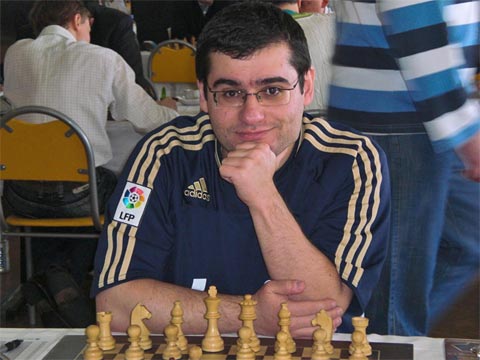 Sergei Movsesian Loek van Wely - Sergei Movsesian Corus Chess Tournament (Group A), Round 11 Wijk aan Zee, 30 January 2009 King's English Game: Three Knights' Opening 1.c4 e5 2.Nc3 Nc6 3.Nf3 g6 4.g3 Bg7 5.Bg2 d6 6.d3 f5
7.0-0 Nf6 8.Rb1 a5
9.a3 0-0 10.b4 axb4 11.axb4 h6 12.b5 Ne7 13.Bb2
13...g5
14.Ra1!?
14...Rxa1
15.Qxa1 Be6?!
16.Qa7!
16...b6 17.Rc1!?
17...Rf7!?
18.Nd2 Kh7 19.Qb7
19...g4 20.Ra1!
20...h5 21.Ra8!
21...Qd7 22.e3 h4 23.Ne2 h3 24.Bf1
24...Ng6 25.d4 f4 26.exf4
26...exf4 27.gxf4?
!""""""""# $r+ + + +% $+qOw+tVl% $ O OvMm+% $+p+ + + % $ +pP Po+% $+ + + +o% $ B NnP P% $+ + +bK % /(((((((() WHITE: Loek van Wely Position after 27.gf4:p 27...d5!
28.Qc6
28...dxc4 29.f5 Bxf5 30.Ng3 Be6 31.Bxc4
31...Bxc4 32.Nxc4 Nd5
33.Qxd7 Rxd7 34.Nf5 Bf6
35.Kf1
35...Rf7 36.Ra7?
!""""""""# $ + + + +% $R O +t+l% $ O + Vm+% $+p+m+n+ % $ +nP +o+% $+ + + +o% $ B + P P% $+ + +k+ % /(((((((() WHITE: Loek van Wely Position after 36.Ra8a7 36...Bg5
37.Nfd6 Rf8?!
38.Ne4 Bf4 39.Ne5
39...Nxe5! 40.dxe5 Bxh2 41.Ra4
41...Kg6 42.Rd4 Ne3+ 43.Ke2
!""""""""# $ + + T +% $+ O + + % $ O + +l+% $+p+ P + % $ + Rn+o+% $+ + M +o% $ B +kP V% $+ + + + % /(((((((() WHITE: Loek van Wely Position after 43.Kf1e2 43...Bxe5
44.fxe3 h2 0-1
|
| Printer Friendly | Permalink | | Top |
| Jack Rabbit
|
Sun Feb-01-09 10:30 PM Response to Reply #3 |
| 8. Navara - Short, Corus B, Round 11, Wijk aan Zee |
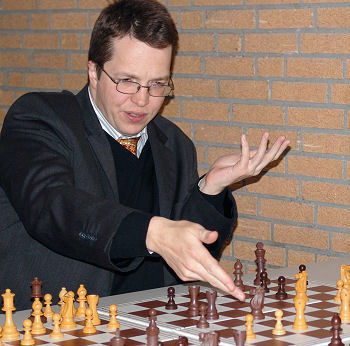 Nigel Short David Navara - Nigel Short Corus Chess Tournament (Group B), Round 11 Wijk aan Zee, 30 January 2009 Moorish Game: Hoseman Defense (Alekhine's Defense) 1.e4 Nf6 2.e5 Nd5 3.d4 d6 4.Nf3
4...dxe5
5.Nxe5 c6 6.Be2
6...Bf5
7.g4
7...Be6 8.f4
8...f6 9.Nd3 Bf7 10.0-0 Na6 11.Nc3 e6!?
12.Nxd5
12...Qxd5 13.Be3 Be7
14.Bf3 Qd7 15.c3 Rd8 16.Qe2 0-0 17.Kh1
17...Nc7 18.Rae1 Bg6 19.Bf2
19...Rfe8 20.Rg1
20...Bd6 21.Bg3
21...Nd5 22.Nc5
22...Qc8 23.g5 b6!?
24.Nxe6?
!""""""""# $ +wTt+l+% $O + + Oo% $ OoVnOv+% $+ +m+ P % $ + P P +% $+ P +bB % $pP +q+ P% $+ + R Rk% /(((((((() WHITE: David Navara Position after 24.Nc5e6:p 24...Bf5!
25.Bg4
25...Rxe6 26.Qxe6+
26...Qxe6 27.Rxe6 Bxg4 0-1
|
| Printer Friendly | Permalink | | Top |
| Jack Rabbit
|
Sun Feb-01-09 10:53 PM Response to Reply #3 |
| 9. Carlsen - Smeets, Corus A, Round 12, Wijk aan Zee |
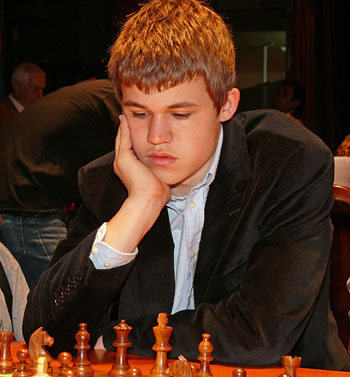 Magnus Carlsen Magnus Carlsen - Jan Smeets Corus Chess Tournament (Group A), Round 12 Wijk aan Zee, 31 January 2009 German Exchange Game: Accelerated Panov Opening (Caro-Kann Defense) 1.c4 c6 2.e4 d5 3.exd5 cxd5 4.cxd5
4...Nf6 5.Nc3 Nxd5 6.Nf3 Nc6
7.Bb5 e6
8.0-0 Be7 9.d4 0-0 10.Re1 Bd7
11.Bd3 Rc8
12.Nxd5
12...exd5 13.Ne5 Bf6!?
14.Bf4 g6 15.Qb3 Na5 16.Qb4 Be6 17.Bh6
17...Bg7?!
18.Bxg7 Kxg7 !""""""""# $ +tW T +% $+ + +oLo% $ + +v+o+% $M +oN + % $ Q P + +% $+ +v+ + % $pP + PpP% $R + R K % /(((((((() WHITE: Magnus Carlsen Position after 18...Kg8g7:B 19.h4?
19...Re8 20.h5
20...f6
21.Nf3 b6?!
22.Bb5!
22...Re7 23.Re2 Rcc7?
24.Rae1!
24...Kf7 25.Qd2 Qf8
!""""""""# $ + + W +% $O T Tl+o% $ O +vOo+% $Mb+o+ +p% $ + O + +% $+ + +n+ % $pP QrPp+% $+ + R K % /(((((((() WHITE: Magnus Carlsen Position after 25...Qd8f8 26.Qf4!
26...Bf5 27.g4 Bc8 28.b4
28...Nb7 29.Bc6 1-0
|
| Printer Friendly | Permalink | | Top |
| Jack Rabbit
|
Mon Feb-02-09 12:04 AM Response to Reply #3 |
| 10. Domínguez - Aronian, Corus A, Round 11, Wijk aan Zee |
 Lenier Domínguez Lenier Domínguez - Levon Aronian Corus Chess Tournament (Group A), Round 11 Wijk aan Zee, 30 January 2009 Spanish Grand Royal Game: Anti-Marshall Opening 1.e4 e5 2.Nf3 Nc6 3.Bb5 a6 4.Ba4 Nf6 5.0-0 Be7 6.Re1 b5 7.Bb3 0-0 8.d4
8...Nxd4
9.Nxd4
9...exd4 10.e5 Ne8 11.c3
11...dxc3 12.Nxc3 d6 13.Bd5!?
13...Rb8
14.Be3 Be6 15.Ba7
15...Bxd5
16.Bxb8 Bb7
17.Ba7 Qa8?!
18.exd6
18...Bxd6 19.Bd4 b4 20.Na4 Bxg2 21.Rxe8
21...Qxe8
22.Kxg2 c5?!
!""""""""# $ + +wTl+% $+ + +oOo% $o+ V + +% $+ O + + % $nO B + +% $+ + + + % $pP + PkP% $R +q+ + % /(((((((() WHITE: Lenier Domínguez Position after 22...c7c5 23.Be3!
23...Qc6+ 24.f3
24...Re8 25.Bf2 c4 26.Nb6
26...c3
27.bxc3 bxc3 28.Qd5
28...Qc7 29.Nc4 Bb4
30.Rc1 Re2?
!""""""""# $ + + +l+% $+ W +oOo% $o+ + + +% $+ +q+ + % $ Vn+ + +% $+ O +p+ % $p+ +tBkP% $+ R + + % /(((((((() WHITE: Lenier Domínguez Position after 31.Re8e2 31.Rxc3!!
31...h6 32.Re3 Rxa2 33.Re8+ Kh7
34.Ne3 Rxf2+
35.Kxf2 Bc3 36.Kg2 1-0
|
| Printer Friendly | Permalink | | Top |
| Jack Rabbit
|
Mon Feb-02-09 12:07 AM Response to Reply #3 |
| 11. Svidler - van Eijk, Round 1, Gibraltar |
 Peter Svidler Peter Svidler - Sander van Eijk Gibtelecom Masters, Round 1 Gibraltar, 27 January 2009 Open Sicilian Game: O'Kelly Defense 1.e4 c5 2.Nf3 a6 3.c4 Nc6 4.d4 cxd4 5.Nxd4 e5 6.Nf5 d6 7.Nc3 g6 8.Ne3 Nge7!?
9.h4!?
9...h5
10.Nc2 Bg7 11.Be3 0-0
12.Qd2 Be6
13.0-0-0 Qa5 14.Kb1!?
14...b5?
!""""""""# $t+ + Tl+% $+ + MoV % $o+mOv+o+% $Wo+ O +O% $ +p+p+ P% $+ N B + % $pPnQ Pp+% $+k+r+b+r% /(((((((() WHITE: Peter Svidler Position after (move) 15.Nd5!
15...Qxd2
16.Rxd2 bxc4 17.Bxc4 Nxd5
18.Bxd5 Bd7 19.Bb3 Rfd8
20.Rxd6 Be8 21.Rxg6! Kh8 !""""""""# $t+ Tv+ L% $+ + +oV % $o+m+ +r+% $+ + O +o% $ + +p+ P% $+b+ B + % $pPn+ Pp+% $+k+ + +r% /(((((((() WHITE: Peter Svidler Position after 21...Kg8h8 22.Bxf7!!
22...Bxf7 23.Rxc6 Rdc8
24.Rxc8+ Rxc8 25.Rd1 1-0
|
| Printer Friendly | Permalink | | Top |
| Jack Rabbit
|
Mon Feb-02-09 12:09 AM Response to Reply #3 |
| 12. Vachier Lagrave - Dzagnidze, Round 3, Gibraltar |
|
Newly minted grandmaster (not WGM, but full grandmaster) Nana Dzagnidze of Georgia, who won an individual gold medal at the chess Olympics in Dresden last autumn, won her first three games in Gibraltar, earning the right to play on the top board in the fourth round.
You go, girl. 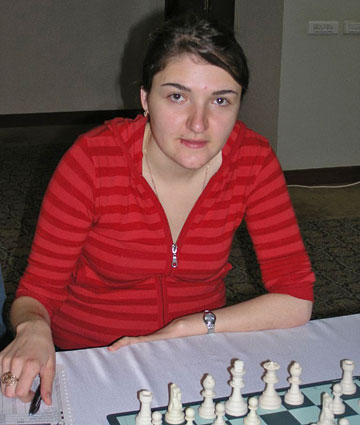 Nana Dzagnidze Maxime Vachier Lagrave - Nana Dzagnidze Gibtelecom Masters, Round 3 Gibraltar, 29 January 2009 Open Sicilian Game: Royal Dragon Defense 1.e4 c5 2.Nf3 Nc6 3.Nc3 g6 4.d4 cxd4 5.Nxd4 Bg7 6.Nb3
6...d6 7.Be2 Nf6 8.0-0 0-0 9.Re1 Be6
10.Bg5
10...a5
11.a3!?
11...a4
12.Nd2 Ra5
13.Be3 d5 14.exd5
14...Nxd5 15.Nxd5 Rxd5 16.c3
16...Ne5 17.Bd4
!""""""""# $ + W Tl+% $+o+ OoVo% $ + +v+o+% $+ +tM + % $o+ B + +% $P P + + % $ P NbPpP% $R +qR K % /(((((((() WHITE: Maxime Vachier Lagrave Position after 17.Be3d4 17...Rxd4!?
18.cxd4 Qxd4
19.Nf1
19...Nc6 20.Qxd4?!
!""""""""# $ + + Tl+% $+o+ OoVo% $ +m+v+o+% $+ + + + % $o+ Q + +% $P + + + % $ P +bPpP% $R + RnK % /(((((((() WHITE: Maxime Vachier Lagrave Position after 20.Qd1d4:Q 20...Bxd4!
21.Bb5 Bxb2
22.Rab1 Bc3
23.Rec1 Bf5 24.Bxc6
24...bxc6 25.Rb7 Bd4
26.Rxe7 Rb8
27.Ree1!?
27...c5 28.Ng3
28...Bd3!?
29.Ne2 Bb2 30.Rxc5 Bxa3 31.Re5
31...Bb2 32.Re3 Bc2 33.Nc3
33...Kf8 !""""""""# $ T + L +% $+ + +o+o% $ + + +o+% $+ + + + % $o+ + + +% $+ N R + % $ Vv+ PpP% $+ + R K % /(((((((() WHITE: Maxime Vachier Lagrave Position after 33...Kg8f8 34.Nxa4?
34...Bxa4 35.h4
35...h5 36.Re4
36...Bc2 37.Rc4 Bf5 38.g3 Bf6 39.Ra4
39...Rb2 40.Ra8+ Kg7 41.Rae8 Be6
42.Rd1 Bc3 43.Red8 Ba5
44.R8d4 Bg4 45.Rc1
45...Bd2 46.Ra1 Bc3 47.Rc4
47...Be5 48.Rac1 Bf5 49.Re1
49...Bd3 50.Ra4 Bb5 51.Rae4 Bc7 52.Rc1 Bb6 53.Rf4 f5
54.Rd1 Bc6 55.Rc1 Be4 56.Re1 Rb4 57.Rc1 Bd4 0-1
|
| Printer Friendly | Permalink | | Top |
| DU
AdBot (1000+ posts) |
Thu Apr 18th 2024, 01:54 AM Response to Original message |
| Advertisements [?] |
| Top |
| Home » Discuss » Topic Forums » Sports |
|
Powered by DCForum+ Version 1.1 Copyright 1997-2002 DCScripts.com
Software has been extensively modified by the DU administrators
Important Notices: By participating on this discussion board, visitors agree to abide by the rules outlined on our Rules page. Messages posted on the Democratic Underground Discussion Forums are the opinions of the individuals who post them, and do not necessarily represent the opinions of Democratic Underground, LLC.
Home | Discussion Forums | Journals | Store | Donate
About DU | Contact Us | Privacy Policy
Got a message for Democratic Underground? Click here to send us a message.
© 2001 - 2011 Democratic Underground, LLC